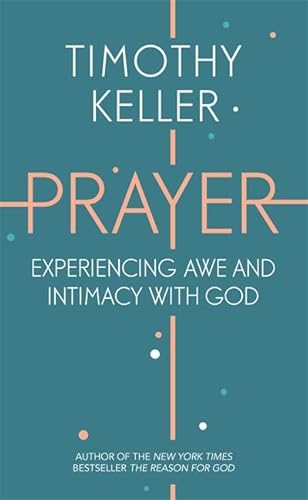Articles liés à Prayer: Experiencing Awe and Intimacy with God

Synopsis
'"Can't anyone teach me how to pray?" Millions of people today are asking the same question. There is a sense of the necessity of prayer - we have to pray. But how?' Prayer is central to Christian faith; indeed, as Timothy Keller notes in his introduction, it is the main way we experience deep change. Yet so many people struggle with prayer - a struggle that the author himself has shared. This wise and inspiring book is the fruit of those struggles, offering a real and glorious vision of what it can mean to seek God in prayer. Keller begins by giving a theological underpinning of what prayer actually is - both conversation and encounter with a personal God - before describing how we can learn to pray, and then deepen that prayer. Finally he gives detailed, practical suggestions on how to make prayer a part of the reality of daily life.
Les informations fournies dans la section « Synopsis » peuvent faire référence à une autre édition de ce titre.
À propos de l?auteur
Timothy Keller was born in Pennsylvania and educated at Bucknell University, Gordon-Conwell Theological Seminary, and Westminster Theological Seminary. He became a Christian at university, was ordained by the Presbyterian Church in America and worked as a pastor for nine years. He was asked to start Redeemer Presbyterian Church in Manhattan in 1989, and under his leadership the church's congregation experienced unprecedented growth from 50 to 5000 members. His target audience consists mainly of urban professionals, whom he believes exhibit disproportionate influence over the culture and its ideas. The 'Influentials' Issue of New York Magazine featured Dr. Keller as "the most successful Christian evangelist in the city by recognizing that young professionals and artists are 'disproportionately influential' in creating the country's culture and that you have to meet this coveted demographic on its own terms." Timothy Keller is renowned for his clear, reasoned approach to Christian apologetics and his book THE REASON FOR GOD: BELIEF IN AN AGE OF SKEPTICISM was named Book of the Year for 2008 by World Magazine. Timothy Keller lives in New York City with his wife Kathy and sons David, Michael and Jonathan.
Les informations fournies dans la section « A propos du livre » peuvent faire référence à une autre édition de ce titre.
EUR 3,43 expédition depuis Royaume-Uni vers France
Destinations, frais et délaisRésultats de recherche pour Prayer: Experiencing Awe and Intimacy with God
Prayer: Experiencing Awe and Intimacy with God
Vendeur : Bahamut Media, Reading, Royaume-Uni
Hardcover. Etat : Very Good. This book is in very good condition and will be shipped within 24 hours of ordering. The cover may have some limited signs of wear but the pages are clean, intact and the spine remains undamaged. This book has clearly been well maintained and looked after thus far. Money back guarantee if you are not satisfied. See all our books here, order more than 1 book and get discounted shipping. N° de réf. du vendeur 6545-9781444750157
Quantité disponible : 1 disponible(s)
Prayer: Experiencing Awe and Intimacy with God
Vendeur : AwesomeBooks, Wallingford, Royaume-Uni
Hardcover. Etat : Very Good. Prayer: Experiencing Awe and Intimacy with God This book is in very good condition and will be shipped within 24 hours of ordering. The cover may have some limited signs of wear but the pages are clean, intact and the spine remains undamaged. This book has clearly been well maintained and looked after thus far. Money back guarantee if you are not satisfied. See all our books here, order more than 1 book and get discounted shipping. N° de réf. du vendeur 7719-9781444750157
Quantité disponible : 1 disponible(s)
Prayer: Experiencing Awe and Intimacy with God
Vendeur : WorldofBooks, Goring-By-Sea, WS, Royaume-Uni
Paperback. Etat : Very Good. The book has been read, but is in excellent condition. Pages are intact and not marred by notes or highlighting. The spine remains undamaged. N° de réf. du vendeur GOR006335642
Quantité disponible : 8 disponible(s)
Prayer: Experiencing Awe and Intimacy with God
Vendeur : WorldofBooks, Goring-By-Sea, WS, Royaume-Uni
Paperback. Etat : Fine. N° de réf. du vendeur GOR008158662
Quantité disponible : 1 disponible(s)
Prayer: Experiencing Awe and Intimacy with God
Vendeur : WeBuyBooks, Rossendale, LANCS, Royaume-Uni
Etat : Like New. Most items will be dispatched the same or the next working day. An apparently unread copy in perfect condition. Dust cover is intact with no nicks or tears. Spine has no signs of creasing. Pages are clean and not marred by notes or folds of any kind. N° de réf. du vendeur rev4286756390
Quantité disponible : 1 disponible(s)
Prayer: Experiencing Awe and Intimacy with God
Vendeur : WeBuyBooks, Rossendale, LANCS, Royaume-Uni
Etat : Very Good. Most items will be dispatched the same or the next working day. A copy that has been read, but is in excellent condition. Pages are intact and not marred by notes or highlighting. The spine remains undamaged. N° de réf. du vendeur rev2035332737
Quantité disponible : 2 disponible(s)

